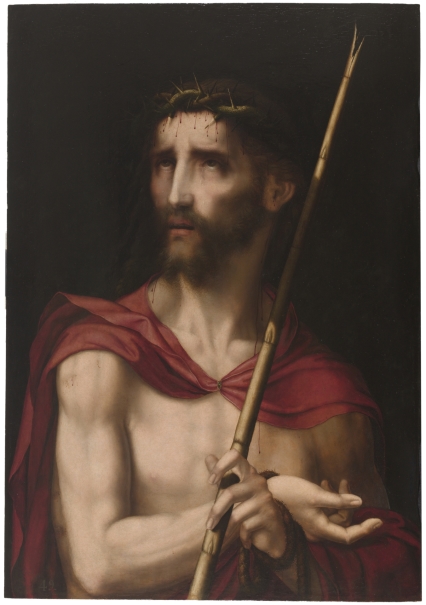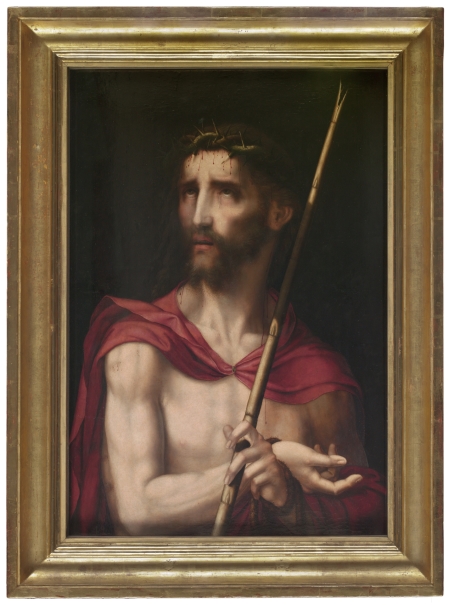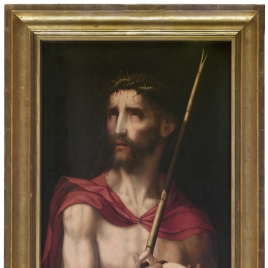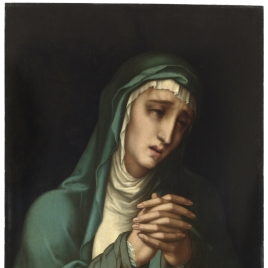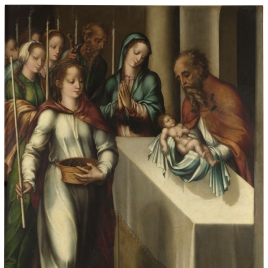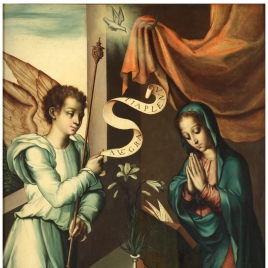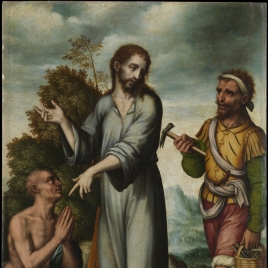Ecce Homo
1560 - 1570. Oil on panel.On display elsewhere
Jesus is shown half-length, crowned with thorns and with a haggard face, parted lips, prominent cheekbones, and moist eyes raised in an attitude of submission to the divine will. His hair, beard, moustache and eyelashes are minutely rendered in a light brown colour. Similarly detailed is the treatment of the tears and drops of blood. The latter, caused by the thorns piercing his forehead and the whiplashes inflicted during the flagellation, run downwards, beginning on the face, passing down the neck and ending on the breast. The pale tone of his body contrasts with the reddish colouring of the robe, which is thrown over his shoulders and fastened with a button. His hands are crossed and tied together with a rope, while the left hand holds the reed which serves as his sceptre, resulting in a somewhat forced pose.
Iconographically, this is the pitiful image of a carnivalesque king, a burlesque version of his true nature, with crown and sceptre included. These images of the Ecce Homo, with all its canonical attributes, are inspired by the episode in which Jesus is condemned to death before the multitude at the Praetorium. In the words of the Gospel according to St John (19, 5:) Then came Jesus forth, wearing the crown of thorns, and the purple robe. And Pilate saith unto them, Behold the man! (in Latin, Ecce Homo). In this instance he is not accompanied either by Pilate or by other possible figures, since the gaze is centred on the protagonist of the action, the Saviour crowned with thorns or man of sorrows. For this scene, the account followed is that of the Gospel according to St Matthew (27, 28-29:) And they stripped him, and put on him a scarlet robe, and when they had plaited a crown of thorns, they put it upon his head, and a reed in his right hand.
The typology of the Ecce Homo derives from Christ Derided by Giampetrino (c. 1495-1540), preserved at the Pinacoteca Ambrosiana in Milan, from which it takes the pose of the shoulders, the turn of the head and the crossed hands. Morales painted a great many versions of the Ecce Homo, and a large number are attributed to him. Besides the panel discussed here, two other examples are known with the right arm bare and one of the palms raised: one in the Katz Collection in England, and another that was auctioned at Sotheby’s on 8 December 2011. There are three other very well-known versions with the palm of one hand raised, but with the left arm bare: the one at the Academia de San Fernando in Madrid, another auctioned at Sotheby’s on 9 December 2004, and the one at the Hispanic Society of America in New York. In the latter case, there may have been an intervening inverted transfer, since there are not many versions of the Ecce Homo with similar characteristics. Also worthy of note is the upward gesture of the eyes, an action repeated in works like St Stephen at the Museo de Bellas Artes de Asturias and at the Museo del Prado (P7117), St Jerome in the Wilderness at the National Gallery of Ireland, and St Francis of Assisi in the Colección Masaveu, Oviedo.
As we have remarked, Morales’s renditions of the Ecce Homo and The Virgin Dolorosa were extremely popular, a fact proved by the large number of known versions, whether by the artist himself, workshop pieces or copies. The paintings from the palace of El Pardo are autograph works by the master, and their authorship has never been questioned. They clearly form a pair, but it is not so obvious that they should be regarded as a diptych, since there are no traces of hinges on the panels. They are superbly executed pieces which transmit the drama with great elegance and speak directly to the hearts of the faithful of the anguish and torture suffered by the characters. They are painted with cold colours (greys, bluish whites, deep blues, pale crimsons) on a smooth black background, and this, together with the expressiveness of the figures, communicates a highly emotional pathos that escapes from the ordinary to enter mystic experience (Text drawn from Yeguas Gassó, J. in: The Divine Morales, Museo Nacional del Prado, 2015, pp. 133-136).





